Vehicle Inspection
|
Navigation Links |
Purpose / Aim
The purpose of the vehicle inspection is to collect data that describes the vehicles involved in an accident, including general vehicle information, its condition, damage, safety equipment and occupant information, to a level that will enable a detailed case analysis and accident reconstruction. The Vehicle Inspection also includes the collection of data relevant to any child occupants such as the use of child restraint systems (please also refer to the Vulnerable Road User section). A Vehicle should be considered as a part of the case and thus investigated as soon as has had a collision even if it has no active role in the accident. However parked vehicles without occupants are excepted and should only be considered as a collision object if they have been hit by a case vehicle.
The vehicle inspection attempts to collect vehicle related information which is needed to subsequently fully code the accident case in the database. This information includes:
- Photographs of the vehicle exterior, interior and accident traces (see: Photo Routine)
- General information about the vehicle (e.g. make, model, engine, gearbox type, cargo, etc.)
- Deformations of the vehicle due to the accident (e.g. CDC, deformation measurements, etc.)
- Exterior observations (e.g. functionality of doors, deformation of door hatches, damage to windows, etc.)
- Interior observations (e.g. intrusions, information on airbags and seat belts, seat positions, marks from passengers due to a collision)
- Vehicular Event Data Recorder information (if applicable)
- Identification of vehicular safety systems from inside and outside the vehicle (e.g. ABS, electronic stability program, lane departure warning, Alcolock system, cruise control, etc.)
Methods
Vehicle inspections can be conducted on scene or retrospectively. Much of the on scene data to be collected may only be available for a finite period (due to accident vehicle towing, etc.). Where possible, accident investigators should make efforts to collect any on scene data that cannot be collected retrospectively.
The Vehicle Inspection methodology is divided into On Scene and Retrospective as the methodology used to conduct these two investigations differ. Despite these differences, it is important to understand that most data required for an accident analysis can be collected on scene, depending on time constraints, obviating the requirement for a retrospective investigation.
AS MUCH ON SCENE EVIDENCE SHOULD BE COLLECTED AS POSSIBLE.
The methods outlined within this section should be applied in conjunction with relevant Detailed Methodology sections.
On Scene
The On Scene investigation is the collection of accident vehicle related evidence at the accident scene location, with a focus on the collection of evidence that is only available for a finite period.
The methodology for the On Scene investigation has been divided into the following steps:
1. Pre-Departure Preparations
After receiving an accident alarm, the investigation team should ensure they have all necessary investigation equipment (see here: Equipment List) and fulfilled all Health and Safety requirements.
2. Arrival On Scene
Once arriving on scene, the investigation team should meet the requirements of the Arrival on Scene and Scene Safety Health and Safety section to ensure a safe working environment.
After meeting the above stated health and safety requirements, the investigation team should identify all those involved in the accident (i.e. all road users and accident witnesses), those involved in the rescue process (i.e. ambulance and police services) and any other relevant parties (i.e. tow truck driver). These individuals can provide the accident team with relevant information and better enable the overall accident investigation process. Furthermore, it is usually necessary to receive permission from the accident vehicle owner (and in some cases, the police) to access the interior of their vehicle.
From speaking with the relevant authorities, the investigation team should determine if and where the accident vehicle(s) will be available for a retrospective investigation, an estimate of the length of time the vehicles will be available on scene and a description of any changes made to the vehicles in the rescue and cleanup process.
3. Vehicular Photographs
Photographic evidence of the accident vehicle(s) should be recorded. The detailed methodology for this process is described in the Photo Routine section.
4. Transient Evidence
Some key vehicular evidence may only be available for a finite period and may not be available during subsequent retrospective investigations. Therefore, accident investigators should collect this data as soon as possible.
Transient evidence includes: pedestrian swipes, biological traces, vehicular fluid traces, debris, interior cargo and broken glass found within and on the vehicle.
5. Additional Evidence
All additional evidence (that which is not considered transient) can usually be collected retrospectively, therefore the detailed methodology for completing the vehicle inspection is detailed below in the Retrospective section. Although, it should be noted that ideally all evidence should be collected on scene, if time allows.
Retrospective
The retrospective investigation is the collection of accident vehicle related evidence at the accident vehicle storage location (e.g. scrap yard, garage, home of the owner, etc), with a focus on evidence that was not collected during the on scene investigation. The vehicle investigation should preferably be completed on scene as transient evidence may still be visible, however, due to the time consuming nature of the inspection itself and the sometimes limited available time frame at the accident scene, it may be necessary to complete the vehicle inspection retrospectively. In this case, the inspection should be completed as soon as possible at the accident vehicle storage location.
The methodology for the retrospective investigation has been divided into the following steps:
1. Pre-Departure Preparations
After determining the accident vehicle storage location, the investigation team should ensure they have all necessary investigation equipment (see here: Equipment List) and fulfilled all Health and Safety requirements.
If not already done so, the investigation team should procure permission to enter the accident vehicle from the owner and any other relevant authority.
2. Arrival at Accident Vehicle Storage Location
Once arriving at the accident vehicle storage location, the investigation team should identify the vehicle to be inspected. This may seem trivial, but depending on the extent of damage and number of similar vehicles at the storage location, care should be taken to ensure the correct vehicle is inspected. This can be facilitated through comparison of the VIN number plate and/or chassis number on the vehicle to the vehicle registration.
After the accident vehicle to be inspected has been identified, it may be necessary for the investigation team to receive assistance (from the wrecker or tow truck operator) to move the vehicle to a place that will allow adequate area around the vehicle to facilitate the inspection.
For safety reasons, the investigators should also ensure that the vehicles battery is unplugged and any airbag systems are deactivated.
3. Vehicular Photographs
If not collected during the on scene investigation, photographic evidence of the accident vehicle(s) should be recorded. The detailed methodology for this process is described in the Photo Routine section.
4. General Vehicle Information
General information about the accident vehicle should be collected by the investigation team during the vehicle inspection. This includes information regarding the vehicles:
- Make / Model
- Fuel and Powertrain
- Geometry and Weight
- Cargo
- Modifications
The majority of this information should be determinable from the vehicles registration certificate, visual inspection of the vehicle and through interview with the vehicle owner.
5. Deformations
Vehicular deformations resulting from the accident are measured and recorded by the investigation team during the vehicle inspection in order to determine the extent of damages and to categorize the deformations. A systematic approach is applied to record the deformations, which should allow investigators a more accurate correlation between impacts and road user injuries in their analysis.
6. Exterior Observations
Exterior observations should be recorded by the investigation team during the vehicle inspection. These observations include:
- Evidence of fire damage
- Fuel system and battery damage
- Observed fluid leakage
- Condition of doors, windows and glazing
- Description and condition of wheels and tyres
- Trailer information (if applicable)
The majority of this information should be determinable from visual inspection of the vehicle and through interview with the vehicle owner.
7. Interior Observations
Interior observations should be recorded by the investigation team during the vehicle inspection. These observations include:
- Condition of interior vehicular components (e.g. steering wheel, dash panel, footwell, etc.)
- Belt and seat description
- Airbag system description
- General interior observations (e.g. impact marks)
The majority of this information should be determinable from visual inspection of the vehicle, vehicle manufacturer information and through interview with the vehicle owner.
8. Event Data Recorder
Vehicles equipped with Event Data Recorders may offer investigators additional information about the accident that may aid in the overall analysis.
9. Safety Systems
A description of the accident vehicles safety system should be recorded by the investigation team during the vehicle inspection. Aspects of the system that should be noted include:
- Support and warning systems (e.g. cruise control, lane departure warning, GPS, etc.)
- Brake and handling system description
- Visibility system (e.g. xenon lights, night vision, etc.)
The majority of this information should be determinable from visual inspection of the vehicle, vehicle manufacturer information and through interview with the vehicle owner.
Powered Two Wheelers
Special consideration is required when investigating accidents involving Powered Two Wheelers (PTW) as there are differences between a PTW and a standard vehicle (i.e. car) inspection. For this reason, this section is devoted specifically to the particularities of PTW inspections.
A PTW inspection should be carried out in the same format and methodology as described above for a standard vehicle inspection with the following particularities:
Photo Routine
The photo routine will differ from the standard vehicle inspection in that there will be no interior photos in the case of PTW investigation.
Paculiarities of the PTW photo routine can be found in the Powered Two Wheeler section of the Photo Routine.
Deformations
Special consideration should be given to any deformations and/or marks as they can reveal much in regards to the kinematics and overall understanding of the accident event.
Braking System
PTW braking systems differ significantly from car systems and require special consideration.
Some PTW are equipped with ABS brakes and should be verified by the owner or by consulting manufacturer specifications.
Visual inspection of the brakes (both front and rear) should be performed, followed by capturing relevant photographic evidence.
Inspection of the brake controls should also be made. Most PTW have separate left and right handlebar brake controls, controlling the front and rear brakes. In some PTW's, the rear brake is controlled by the right foot.
Tyre Thread Depth
PTW tyres require significant thread depth and curvature to maximise road area contact while leaning through a curve. The depth of the tread should be well noted during the inspection.
Trucks
Special consideration is required when investigating accidents involving trucks (Heavy Vehicles) as there are differences between a truck and a standard vehicle (i.e. car) inspection. For this reason, this section is devoted specifically to the particularities of truck inspections.
A truck inspection should be carried out in the same format and methodology as described above for a standard vehicle inspection with the following particularities:
Truck Type
There are various types of truck trailers and body types in use. It is useful for the investigator to determine the type in use.
Please see the below figure for some common truck types.

Figure 1: Common Heavy Vehicle trailer types
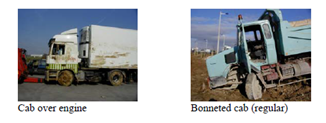
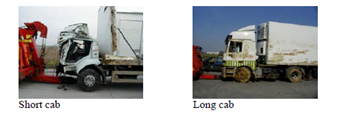
Figures 2-3: Common Heavy Vehicle cab types
Load Type
Trucks that contain loads that may be considered hazardous (e.g. flammable, explosive, etc.) should display their load type on the exterior of the vehicle.
Signs displaying the hazardous material type should state the type of hazard that the truck contains.
The hazardous material type should be recorded for each truck investigated.
Sample load hazard types are shown in the figure below.
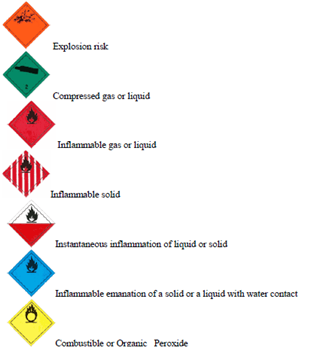
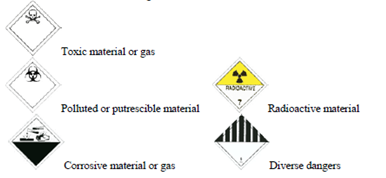
Figure 4: Heavy Vehicle hazardous load signs
Vehicle Specifications
Certain truck specifications are usually stated on a plate on the side of the vehicle. This plate can contain information regarding the empty weight, length, width and surface area of the vehicle.
This evidence is useful to the investigator and should be recorded. Furthermore, if the load is still present, it may be determinable if the vehicle was overloaded in the accident.
A sample specifications plate is shown in the figure below.
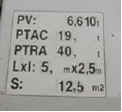
Figure 5: Specifications plate (values from top to bottom: vehicle weight with no load, gross vehicle weight rating, authorised gross vehicle weight, length and width measurements (respectively), surface area)
Tachograph System
Some trucks are equipped with a tachograph system. A tachograph system states the number of working and resting hours for the truck.
Tachograph systems are predominantly either digital or analogic. In the case of an anologic system, a photograph of the display reading should suffice as an adaquete record. In the case of a digital system, card access may be required.
Sample tachograph system output is shown below.
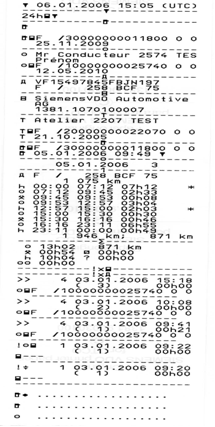
Figure 6: Tachograph readings
Buses
Special consideration is required when investigating accidents involving buses as there are differences between a bus and a standard vehicle (i.e. car) inspection. For this reason, this section is devoted specifically to the particularities of bus inspections.
A bus inspection should be carried out in the same format and methodology as described above for a standard vehicle inspection with the following particularities:
Bus Type
There are various types of buses in use and the type of bus involved in the accident should be determined and recorded.
Occupant Allowance
Buses are somewhat unique to other vehicle types in that they allow for standing occupants. In addition to the number of seat placements within the bus, the number of permitted standing occupants should be determined and recorded.
Equipment
Please refer to the Equipment List for the Vehicle Inspection equipment list.
Arrangements
Please refer to the Arrangements section of the Methodology Outline Vehicle Inspection section.
